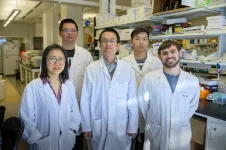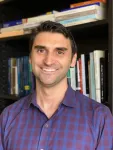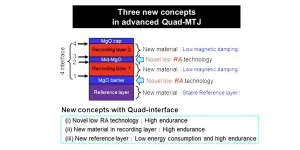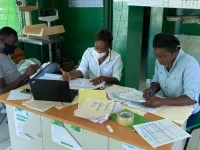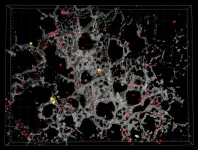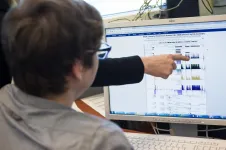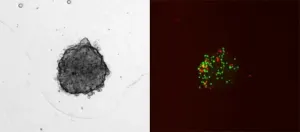(Press-News.org) Global oceans absorb about 25% of the carbon dioxide released into the atmosphere when fossil fuels are burned. Electricity-eating bacteria known as photoferrotrophs could provide a boost to this essential process, according to new research from Washington University in St. Louis.
Scientists led by Arpita Bose, assistant professor of biology in Arts & Sciences, found that bacteria found in brackish sediments can "eat" electricity and, in the process, absorb and lock away climate-warming carbon dioxide. This unusual skill was previously thought to be almost exclusive to freshwater bacteria, but may be common in marine bacteria. The study was published May 30 in The ISME Journal, an official journal of the International Society of Microbial Ecology.
"These microbes are fixing and sequestering carbon dioxide and they can both 'eat' electricity and perform photoferrotrophy," Bose said. "Photoferrotrophs use soluble iron as an electron source for photosynthesis while fixing carbon dioxide. Marine environments are great places for them because they are rich in many things they need.
"We are interested in these microbes because of their role in carbon sequestration," she said. "Perhaps these microbes can be important for combating climate change."
The first photoferrotrophs that scientists isolated in the 1990s came from freshwater ecosystems. Only two marine photoferrotrophs have previously been discovered, but those bacteria are difficult to keep alive in a lab setting.
"This really hampered investigations on marine photoferrotrophs," Bose said.
For the new work, Bose returned to one of her favorite places to hunt for bacteria, Woods Hole, Massachusetts, and the Trunk River estuary. There, she and members of her team isolated 15 new strains of the common marine anoxygenic phototrophic bacteria Rhodovulum sulfidophilum.
"We found that all the Rhodovulum strains were capable of photoferrotrophy, and we used AB26 as a representative strain to show that it can also consume electricity," Bose said.
In the laboratory, the bacteria were able to harvest electrons directly from an electricity source; in the wild, they likely harvest electrons through rust and other iron minerals that are naturally abundant in marine sediments.
The scientists then conducted some additional tests with one of the strains to further illuminate the pathway that the bacteria use to directly consume electrons. A previously unknown electron-transfer protein appears to be key to the process, although additional research is needed to specifically describe the molecular mechanism.
"Anoxygenic phototrophs, like Rhodovulum sulfidophilum, are broadly distributed in marine ecosystems," said Dinesh Gupta, postdoctoral researcher at the University of California, Berkeley, and co-first author of the new study, who conducted this research as a graduate student in the Bose laboratory. "This study is the first to explore whether they can use insoluble/solid-phase substances as electron donors and if this electron-uptake process could be linked to carbon sequestration or carbon dioxide fixation in the ocean."
Because these bacteria are common and thriving in marine sediments already, they may already hold a key for future engineered approaches to climate change, Bose said.
"We need to understand the extent of carbon sequestration they can do in nature, as it might be a cryptic metabolism," Bose said. "We could also potentiate it further -- both for biotechnology and for the environment. This study is a big step, setting the stage for many future studies."
INFORMATION:
WASHINGTON--A new study finds people who consume two servings of fruit per day have 36 percent lower odds of developing type 2 diabetes than those who consume less than half a serving. The research was published in the Endocrine Society's Journal of Clinical Endocrinology & Metabolism.
Diabetes is a disease where people have too much sugar in their bloodstream, and it is a huge public health burden. Approximately 463 million adults worldwide were living with diabetes in 2019, and by 2045 this number is expected to rise to 700 million. An estimated 374 million people are at increased risk of developing type 2 diabetes, the most common form of the disease. A healthy diet and lifestyle can play a major role in lowering a person's diabetes risk.
"We ...
A new study led by researchers at Washington State University has identified a protein that could be the key to improving treatment outcomes after a heart attack.
Published in the Journal of Biological Chemistry, the research suggests that protein kinase A (PKA) plays a role in heart muscle cell necrosis, a major type of cell death that commonly occurs after reperfusion therapy, the treatment used to unblock arteries and restore blood flow after a heart attack.
"Our study has found that turning off a gene that controls this protein activity increased necrotic cell death and led to more heart injury and worse heart function following heart attack in a rodent model," said study author Zhaokang Cheng, an assistant professor in the WSU College ...
As early as the Neolithic period (circa 3900 BC), the domestication of animals likely led to the development of diseases including measles and smallpox. Since then, zoonotic disease has led to other major transnational outbreaks including HIV, Ebola, SARS, MERS, and H1N1 swine flu, among others. Currently, more than half of all existing human pathogens, and almost three-quarters of emerging infectious diseases, are zoonotic in nature.
COVID-19 is the latest and most impactful zoonotic event of the modern era, but it will certainly not be the last.
Given the breadth of these impacts and the fact that other zoonotic pandemics are highly likely - a matter of when and not if - the key public health ethics question that emerges is about whether it is ethically appropriate for governments ...
Doctors have hoped that antibiotics could benefit patients with chronic lung diseases, but a new study has found no benefit for patients with life-threatening idiopathic pulmonary fibrosis in preventing hospitalization or death.
While there were no statistical benefits for patients with the lung-scarring disease, the new research will prevent unnecessary antibiotic use that could contribute to the growing problem of antibiotic resistance. The nationwide clinical trial - believed to be the largest idiopathic pulmonary fibrosis trial ever conducted - also collected biological samples that will advance the understanding and treatment of the mysterious and ultimately fatal illness.
"We were certainly disappointed in the results. But we remain hopeful that in further downstream ...
(Carlisle, Pa.) -- A new study published in the American Journal of Lifestyle Medicine finds critical links between job loss and physical inactivity in young adults during the U.S. Great Recession of 2008-09 that can be crucial to understanding the role of adverse economic shocks on physical activity during the COVID-19 pandemic. It is the first study to examine how job losses during the Great Recession affected the physical activity of young adults in the United States.
The study by Dickinson College economist Shamma Alam and Harvard T. H. Chan School of Public Health economist Bijetri Bose looked at Panel Study of Income Dynamics (PSID) data for young adults age 18 to 27--a phase of development associated with maturation and significant ...
Professor Tetsuo Endoh's Group at Tohoku University's Center for Innovative Integrated Electronics has announced a new magnetic tunnel junction (MTJ) quad-technology that provides better endurance and reliable data retention - over 10 years - beyond the 1X nm generation.
This novel Quad technology meets the design requirements for the state-of-the-art X nm complementary metal-oxide semiconductor (CMOS) node and will pave the way for ultra-low-power consumption for Internet of Things (IoT) edge-devices in mobile communication, the automotive industry, consumer electronics, ...
Researchers from Telethon Kids Institute and Curtin University in Perth and Tulane University in New Orleans have developed sophisticated data modelling that could help eradicate malaria in Haiti.
Haiti is the poorest country in the Caribbean - beset by natural disasters - and is one of the few countries in the region that have not mostly wiped out the mosquito-borne disease.
Telethon Kids Institute researcher Associate Professor Ewan Cameron led the team, using a range of different health data to create a complete picture of where malaria infections are taking place in Haiti. This information has been used to directly inform Haiti's national response to malaria.
The team's findings ...
Treating patients with acute respiratory failure is a constant challenge in intensive care medicine. In most cases, the underlying cause is lung inflammation triggered by a bacterial infection or - more rarely, despite being frequently observed at present due to the corona pandemic - a viral infection. During the inflammation, cells of the immune system - the white blood cells - migrate to the lungs and fight the pathogens. At the same time, however, they also cause "collateral damage" in the lung tissue. If the inflammatory reaction is not resolved in time, this can result in chronic inflammation with permanent impairment of lung function. Together with colleagues from London, Madrid and Munich, a research team at the University ...
Researchers at the University of Eastern Finland have uncovered potential mechanisms by which microRNAs (miRNA) drive atherogenesis in a cell-type-specific manner. Published in the Arteriosclerosis, Thrombosis, and Vascular Biology journal, the study provides novel insight into the miRNA profiles of the main cell types involved in atherosclerosis.
Atherosclerosis is the underlying cause of most cardiovascular diseases and one of the leading causes of mortality in the world. During atherosclerosis, arteries become progressively narrow and thick due to the formation of plaques containing cholesterol deposits, calcium and cells, among other components. ...
Every tumour is different, every patient is different. So how do we know which treatment will work best for the patient and eradicate the cancer? In order to offer a personalised treatment that best suits the case being treated, a team of scientists led by the University of Geneva (UNIGE), Switzerland, had already developed a spheroidal reproduction of tumours that integrates the tumour cells, but also their microenvironment. However, the immune system had not yet been taken into account, even though it can either be strengthened or destroyed by the treatment given to the patient. Today, the Geneva team has succeeded in integrating two types of immune cells that come directly from the patient into the spheroidal structure, ...
